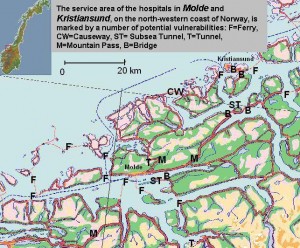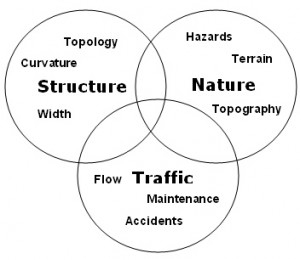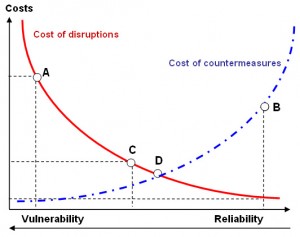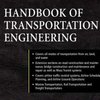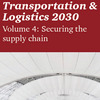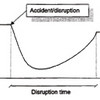 Issues of reliability and vulnerability are mormally not considered a matter of evaluation in traditional cost-benefit analyses. Consequently, traditional cost-benefit analyses are lacking decision variables that may be important. This paper looks beyond the abstract science of vulnerability assessments, and discusses some of the factual influences and network attributes that contribute to the vulnerability of transport networks. The influences of the individual attributes are then examined as a measure of the vulnerability of a transport network. Although reliability can be defined by absolute numbers, vulnerability, by its very nature can not. The paper further outlines a framework for developing a methodology that to incorporate reliability and vulnerability as parameters for decision-support in a cost-benefit analysis. In doing so, this paper seeks to establish a link between the terms reliability/vulnerability and cost/benefit and seeks to describe reliability and vulnerability in terms of cost and benefit. Cost-benefit evaluations are part of many decision making processes, and it is argued that vulnerability assessments likewise should play an important role as input to these processes.
Issues of reliability and vulnerability are mormally not considered a matter of evaluation in traditional cost-benefit analyses. Consequently, traditional cost-benefit analyses are lacking decision variables that may be important. This paper looks beyond the abstract science of vulnerability assessments, and discusses some of the factual influences and network attributes that contribute to the vulnerability of transport networks. The influences of the individual attributes are then examined as a measure of the vulnerability of a transport network. Although reliability can be defined by absolute numbers, vulnerability, by its very nature can not. The paper further outlines a framework for developing a methodology that to incorporate reliability and vulnerability as parameters for decision-support in a cost-benefit analysis. In doing so, this paper seeks to establish a link between the terms reliability/vulnerability and cost/benefit and seeks to describe reliability and vulnerability in terms of cost and benefit. Cost-benefit evaluations are part of many decision making processes, and it is argued that vulnerability assessments likewise should play an important role as input to these processes.
Paper presented at INSTR2004, the Second International Symposium on Transportation Network Reliability, Christchurch and Queenstown, NZ, 20-24 August 2004
INSTR 2004
1 INTRODUCTION
Few will question that the sender, the recipient, the freight hauler or society at large, experience additional costs when goods or persons cannot reach their destinations in time or space. Consequently, it should be obvious that a reliable transport network represents a benefit to society. Equally, a vulnerable network would represent a net cost to society. Why then, is the reliability, or conversely, the vulnerability, of the transport network not a matter of evaluation in traditional cost-benefit analyses?
In the most common manner of speaking, the reliability of a transport network can be defined as the probability that one or more of its links functions, or rather: does not fail to function, according to a set standard of operating variables. A non-functioning, or at best, badly-functioning link will impose costs on the user in terms of loss of time, additional operation costs or other costs as a result of delays and diversions. Transporters of perishable goods will also experience a loss of value. These are socio-economic costs that should be taken into consideration in cost-benefit analyses of transport projects; yet, as a norm, reliability and vulnerability are not evaluated in today’s practice. This means that the evaluation of benefits of proposed new projects and the costs of using existing infrastructure may be lacking important variables.
What is most often lacking in today’s cost-benefit analyses is a specific evaluation of the factors that can lead to a non-functioning of the existing link, the societal costs imposed by not mitigating, and the societal benefits gained by mitigating. For the most part, saved travel time is what drives the policy of the decision makers, increased reliability or lessened vulnerability is as a rule not a subject for closer evaluation; it is simply taken for granted. However, vulnerability assessments should be acknowledged as an integral part of any transport planning process. Aven et al. (2004) note that the transport sector in general has very limited experience with regard to risk based management, and that especially thought processes on acceptable risk and the use of acceptance criteria is not fully developed. Cost-benefit analyses and environmental impact analyses are being used, but risk analyses and risk acceptance criteria are not. Risk as a concept and as a management tool has no marked tradition among the Norwegian road authorities or amongst the international road authorities
Taking up the invitation in Berdica (2002) to bring out and recognise the vulnerability in the road transport system as a meeting point for all the different strands of transport reliability research and other issues (p.127), the focal point of this paper is to look at a road network from a reliability and vulnerability perspective and to link this analysis to cost-benefit decisions.
2 RELIABILITY VERSUS VULNERABILITY
Traditionally, when looking at the reliability of transport networks, it is done with a systems engineering approach. Reliability is here an expression of the probability that links within the network will function, reliability may thus be viewed as the degree of stability of the quality of service that a system offers. In
Bell and Iida (1997), transport network reliability is focused on connectivity reliability (also named terminal reliability) and travel time reliability. Nicholson et al. (2002), in addition, list and discuss encountered reliability, capacity reliability and flow decrement reliability as ways of measuring reliability.
Whereas probability or predictability is a major concern in network reliability studies, the impacts or consequences of disruptions is the main focus of vulnerability studies. Taylor and D’Este (2003a) note that vulnerability and reliability are two related concepts, but emphasise that network vulnerability relates to network weaknesses and the economic and social consequences of network failure, not so much the probability of failure. Berdica (2002) relates vulnerability to serviceability, namely the possibility to use a link, route or road in a network at a given time. Vulnerability, then, is the inability to supply adequate serviceability and serviceability as such is determined by a set of performance measures. Taylor and D’Este (2003b) relate vulnerability to the degree of accessibility of a given node in the network, where accessibility is expressed as the travel cost needed to access the particular node, comparing optimal and alternative routes or detours. LLeras-Echeverri and Sanchez-Silva (2001) extend the minimum path calculations as seen in Bell and Iida (1997), to include a progressive failure scenario approach to identify weak links. By assigning centroids within the network, and restricting the study to failures of links in the minimum paths between the centroids, critical links can be quickly identified and set aside for further evaluation.
What is apparent, is that vulnerability, unlike reliability, needs to be more than a quantitative probability calculation related to the functioning or non-functioning of a network link. Reliability focuses on the possibility of maintaining a link; vulnerability focuses on the possibility of disrupting or degrading a link. The probability of a link being present or not, as with traditional reliability engineering, does not translate into a probability of the same link being operable or not. The term operability needs to be approached differently for different types of roads, road conditions, goods or transports. The probability of the network of being available, accessible and expressing the desired level of service may be used as a measure of reliability. Conversely, the road network’s susceptibility to not being available, accessible and expressing the desired level of service may be construed as a measure of vulnerability, as defined by Berdica (2002). The notion of susceptibility implies something more than probable and statistically predictable failure, namely the influence of external circumstances, circumstances that cannot be predicted, and which may, but not necessarily will have an influence.
With reliability and vulnerability being two different concepts, a measure of reliability does not translate into a measure of vulnerability. Vulnerable may not mean non-reliable and reliable may not mean non-vulnerable. Lessening transport network vulnerability may be different from improving transport network reliability. There may be no linear or reciprocal relationship. Nonetheless, if associating reliable with being operable, and associating vulnerable with being non-operable, then it is warranted to juxtapose reliability with vulnerability: Reliability, in this sense, means non-vulnerability or exhibiting a high degree of operability under any circumstances; vulnerability means non-reliability or exhibiting a low degree of operability under certain circumstances. This is how the terms vulnerability and reliability are used throughout this paper.
3 MEASURES OF VULNERABILITY
For a road network, disruptions are often the result of external influences such as landslides, avalanches or rockfall, flooding, lack of snow clearing during winter, accidents that require extensive clean-up, etc.; the list of scenarios is literally endless. Often seen in Norway, closures of subsea tunnels and failures or severe degradation of ferry services are also among the many factors that will occur with seasonal and/or locational variations. Ferry services may be of no concern in some parts of the country, whereas rockfall can be a major issue in other parts.
Vulnerability can be described as the consequential cost of the lack of reliability under said certain circumstances, and this consequential cost must comprise not only the immediate toll on the road-users, but the overall socio-economic costs on the community that this vulnerability would entail. Thus, the task of a vulnerability analysis is to answer three questions, not only “Vulnerable…where?”, but, in addition, it needs to address “Vulnerable…to what?” or “Vulnerable…how?”, addressing the particular scenario and its impact. The difference between vulnerability and reliability also leads to the tempting conclusion that vulnerability should be not approached from a quantitative perspective, but from a descriptive perspective, at least more so than reliability, and the task is then to find these descriptive measures.
Transport networks are susceptible to a wide range of vulnerabilities that can lead to an operational degradation. These vulnerabilities are the result of certain attributes or qualities pertaining to the network itself. One applicable categorisation of attributes and influences, adapted from Bråthen and Lægran (2004), could be the following three: structure, nature and traffic.
Structure-related or structure-generated vulnerability pertains to the way the road is built, and attributes of the road network itself, not only in terms of topology, and connectivity, but also in terms of the physical body of the road, geometry, width, curvature, gradient, tunnels, bridges, weight restrictions for certain vehicle types, etc. Nature-related or nature-generated vulnerability pertains to attributes of the natural environment, the topography and the terrain that the road traverses, and to nature-given incidents, such as flash floods, avalanches, rockfall, snow and ice, fog, earthquakes, tsunamis, consequences of climate changes, to mention but a few. Traffic-related or traffic-generated vulnerability pertains to attributes describing the generic flow of traffic and attributes resulting in flow decrements, such as daily rush hour and weekend highs, as well as maintenance operations, snow clearing, accident clear-up, and ongoing construction works.
Figure 1: Road networks are vulnerable to 3 influences: structure-related, nature-related and traffic-related. It is the collective sum of these vulnerabilities that needs to be addressed.
Typically, these vulnerabilities will occur on a collective basis, rather than on a one-by-one basis. Even though a particular stretch of road may be susceptible to only one of the aforementioned vulnerabilities, the overall network will be exposed to a collective set of all vulnerabilities, some acerbating the other (figure 1 below). It is the collective sum of these vulnerabilities that needs to be addressed. A vulnerability assessment must consider each attribute separately, and, at the same time, as a whole. Thus, many approaches must be used, and finding one definition or one measure of vulnerability does not seem feasible, or even desired.
4 VULNERABILITY/RELIABILITY AND COST/BENEFIT
The purpose of a cost-benefit analysis is to weigh the costs of a proposed project against the benefits of the project. If the benefits exceed the costs, then the project increases society’s welfare. If the costs exceed the benefits, society will experience a loss of welfare. The argument of vulnerability versus reliability is analogous: Any vulnerability of the transport system causes disruptions that cause costs, which are a loss of welfare; vulnerability is thus a cost that is quantifiable. If society puts measures in place to reduce the vulnerability of the transport network, the increased reliability represents a benefit. In terms of road user utility new projects are generally considered as improvements, the same normally applies to reliability, but, as it may happen in some cases, exchanging one kind of vulnerability for another, while increasing reliability, may in terms of socio-economic impact not be the best solution.
Example: A project is proposed to reduce the impact of avalanches on a selected link on a given route, alleviating that particular vulnerability on this link. This improvement may cause motorists to transfer to this route from other possible routes. If the vulnerabilities of other links along the partially improved route are neglected, then this may in turn affect a larger number of road users then before the particular improvement.
Vulnerability, represented by the consequential costs of a potential operational degradation, is a cost that should be included in a cost-benefit analysis. Likewise, Reliability, representing the consequential benefits of an operational improvement, is a benefit value, which too needs to be included. Today’s project evaluation practice looks almost exclusively at the construction costs on one hand, and the road user utility as the benefit on the other hand, with little or no notion of reliability or vulnerability.
Figure 2: The societal costs of vulnerability versus reliability. A – current state, B – high investment (new road), C – low investment (upgrading existing road), D – optimum
This can be expressed as in figure 2, illustrating the relationship between vulnerability and reliability. The constructions costs, and thus reliability, increase from left to right (dotted line), disruptions costs, and thus vulnerability, increase from right to left (solid line). From a strictly socio-economical point of view, the cost of increasing the reliability should not exceed the cost of vulnerability for society to experience a benefit. The construction costs are included as a cost in cost-benefit analyses; however, saved disruption costs are generally not included as a benefit. Consequently, a proposed investment is not valued correctly, if saved disruption costs are not properly accounted for. The question that arises is whether saved disruption costs actually do represent a utility similar to saved travel costs. Example: To keep a mountain road open during winter one may consider improving the road by building a tunnel or aligning the road differently to alleviate weather exposure, or alternatively, invest in better snow-clearing equipment and increase clearing frequency. Today’s situation is (A), with high disruption costs. Building a new road and/or a tunnel is costly (B), but the probability of disruptions is lessened considerably and the disruption costs are almost negligible. Better snow-clearing equipment (C) reduces the susceptibility to disruptions somewhat – the road is still exposed to severe weather conditions – but the investment costs are much lower than in the former alternative. Note point (D) where the two curves intersect. The expected cost of disruptions (or the expected benefits of avoiding disruptions) is there equal to the cost of countermeasures. D is the socio-economically optimal level of expected disruption costs (and the optimal expenditure on countermeasures). A movement towards D from the left means that it will be cost-effective to implement a countermeasure. A movement rightwards from D means that society will be better off “living with the vulnerability”. In this particular case, better snow-clearing equipment will be a good countermeasure, a new road/tunnel will not. The individual road user may disagree here, but from an overall cost-benefit perspective it is correct.
Any investment into making the infrastructure more reliable or less vulnerable needs to balance these two attributes. An overemphasis on either side will lead to a loss of welfare for the society at large, and consequently, costs and benefits need to be weighed against each other. The issue at hand is to balance the benefit of becoming more reliable/less vulnerable against the cost of remaining vulnerable.
5 CONCLUSION
This paper has sought to bring together three fields of research: engineering (reliability and vulnerability), economics (costs and benefits) and politics (decision- making), with the rationale that the reliability or vulnerability of the transport network only seldom is looked at as a decision parameter in cost-benefit analyses, especially for new projects.
By adding reliability and vulnerability to the traditional equations of costs and benefits, it is thus hoped that transport planners and professionals will not only consider economical arguments, but also dare to take on political statements that may be in opposition to the strictly factual costs and benefits of a project. This is only possible when these arguments are backed up by a full evaluation of the factors that make up the reliability and vulnerability of our infrastructure system. Consequently, some of the directions for future research should be:
1. To establish a practice-oriented methodology for aggregating a vulnerability index for a road network, pertaining to attributes of structure, nature and traffic.
2. To integrate vulnerability within the quantitative and qualitative framework of cost-benefit analyses used in the transport sector.
3. To integrate vulnerability as a decision variable in the evaluation process for new road developments.
As a last remark, it must be said that the aim of this paper was not to find a justifiable measure of vulnerability, but to point at vulnerability as a variable that needs to be taken account of in cost-benefit analyses and in the evaluation of transport networks. Therefore, in its composition, this paper has likely raised more questions than provided solid answers.
It remains to bee seen, then, whether vulnerability and reliability will be a driving force in cost-benefit analyses of future road development projects.
6 REFERENCES
Aven, T and Kørte, J. (2003) On the use of risk and decision analysis to support decision-making. Reliability Engineering and System Safety, 79, pp. 289-299
Bell , M.G.H., Iida, Y. (1997) Network Reliability. In: Transportation Network Analysis, eds. M.G.H. Bell and Y Iida, pp.179-192, John Wiley & Sons, Chichester
Berdica, K. (2002b) An introduction to road vulnerability: what has been done, is done and should be done. Transport Policy, 9, pp. 117-127
Bråthen, S. and Lægran, S. (2004) Bottlenecks in cargo transport in Norway. Draft paper, Molde Research Institute/SWECO Grøner, Norway.
Dalziell, E., & Nicholson, A. (2001). Risk and Impact of Natural Hazards on a Road Network Journal of Transportation Engineering, 127 (2), 159-166
Husdal, J. (2004) Pålitelighet og sårbarhet – et ikke-tema i nyttekostanalyser? Samferdsel 2/2004, s. 28-30. Reliability and vulnerability – a non-issue in cost-benefit analyses? Samferdsel (Journal of the Norwegian Institute for Transport Economics, TØI), 2/2004, pp. 28-30
LLeras-Echeverri, G. and Sanchez-Silva, M. (2001) Vulnerability analysis of highway networks, methodology and case study. Transport 174 (4), pp.223-230.
Bell, M.G.H. and Iida, Y (2001) Assessing Transport Reliability: Malevolence and User Knowledge. In: The Network Reliability of Transport, eds. M.G.H. Bell and Y. Iida, Proceedings of the 1st International Symposium on Transportation Network Reliability, pp.1-22. Elsevier Science, Kidlington.
RISIT (2004) RISIT – Risk and safety in the transport sector – A state-of-the-art review of current knowledge. White paper. The Research Council of Norway
Taylor, M. A. P. and D’Este, G.M.D. (2003a) Network Vulnerability: An Approach to Reliability Analysis at the Level of National Strategic Transport Networks. In: The Network Reliability of Transport, eds. M.G.H. Bell and Y. Iida, Proceedings of the 1st International Symposium on Transportation Network Reliability, pp.23-44. Elsevier Science, Kidlington.
Taylor, M. A. P. and D’Este, G.M.D. (2003b) Concepts of network vulnerability and applications to the identification of critical elements of transport infrastructure. Paper presented at the 26th Australasian Transport Research Forum, Wellington, New Zealand, 1-3 October 2003.
READ ONLINE
RELATED
- husdal.com:
The reliability and vulnerability of transportation lifelines - husdal.com:
Reliability and vulnerability – a non-issue in cost-benefit analyses? - husdal.com:
Reliability and vulnerability versus costs and benefits (ETC2004) - husdal.com:
The reliability and vulnerability of road networks in a cost-benefit perspective (TRB2005) - husdal.com:
Transport network vulnerability – which metrics should we use? (NECTAR2006) - husdal.com:
Are roads more important than computers?

